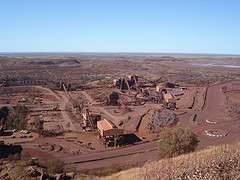The Mt Whaleback mining operation in the Pilbara. Credit: TCL 1961
A UWA geologist says the high-grade iron ore reserve at Wiluna West in the Mid West is similar to those being mined at Mt Tom Price, Paraburdoo and Mt WhaleBack in the Pilbara.
Adjunct research fellow Desmond Lascelles says when the deposits formed, Wiluna West was on a separate tectonic plate to those present-day Pilbara mines.
Nevertheless, he says the geological makeup and other conditions at those locations must have been almost identical.
"The same rock type is found in the Yilgarn craton as in the Pilbara craton," he says.
"Wiluna West is a new discovery of microplaty hematite ore: that's the premium, very high-grade, low-phosphorous, good metallurgical characteristics ore type.
"It's in a series of small ore bodies, and in each deposit you can see the genesis of how it formed."
Dr Lascelles says while these high-grade ores are presently classified as microplaty hematite, they could be given another name because they formed under different conditions and have different characteristics.
"The ore type that's of this premium grade ore isn't microplaty hematite at all, it's 'acicular'," he says.
According to Dr Lascelles, hot fluids coming up from below the deposits turn the true microplaty hematite into banded ironstone formations (BIF).
Ancient weather patterns form particular deposits
However the 'acicular' deposits are simply a weathering product of the silicate minerals that were already present in the sedimentary deposits, caused by rain, wind and ground water.
"The microplaty hematite formed as pseudomorphs of the iron silicate minerals during the sub-aerial exposure in the Paleoproterozoic era (about 2.5 to 2.2 billion years ago)," he says.
"Silicate minerals normally weather to goethite but in the Paleoproterozoic, conditions were sufficiently arid that hematite formed instead.
"The weathered rock hasn't been actually disturbed as such, it's just been chemically changed without any physical changes."
Dr Lascelles made the study when Golden West Resources employed him to carry out geological mapping of the Joyner's Find greenstone belt, which is the company's project.
He conducted field mapping and petrography (looking at rocks under a microscope) using both transmitted and reflected light to examine thin slices of the rocks.
He also analysed geochemical assays that were carried out by several mining companies and by himself.
The Wiluna West deposit is estimated to contain 69.2 million tonnes, including a 2.9 million tonne proven reserve at 59.7 per cent iron.
Provided by Science Network WA























